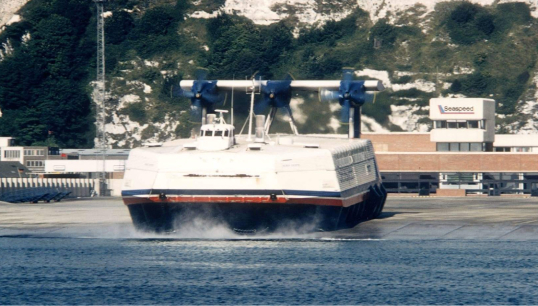Ingenieur Jean Bertin

Hovercraft rivalry
Hovercraft had been running between Britain and France since the mid-1960s and the N500 Naviplane was developed by the French company Sedam, with backing from the country’s government, in a bid to present a rival to the successful British Hovercraft Corporation models, such as the 254-passenger capacity SR.N4.
Sedam – which was founded in 1965 and had built a range of smaller hovercraft – produced proposals for the largest and fastest hovercraft yet, capable of carrying as many as 400 passengers, 55 cars and five coaches at speeds of up to 70 knots.
The build
Powered by five marinised Avco Lycoming TF40 gas turbines – two for lift and three for propulsion – developing 2,386kW, the Naviplane was controlled by rudders and variable pitch propellers and Sedam claimed the ‘new generation’ design would offer lower fuel consumption, simpler maintenance and greater comfort than other craft.
Work on the ambitious Naviplane project began in 1973 and involved extensive research – including tests of scale models to assess dynamic stability, performance in adverse conditions, passenger comfort, and manoeuvrability.
With two orders in the bag and interest expressed from as far away as Canada, construction of the first two N500s began in 1976 and the first craft, Côte d’Argent, successfully completed trials in April 1977. But barely a fortnight later it was destroyed in a fire which began when a broken lamp ignited a bucket of adhesive solvents during maintenance work.
The second N500, Ingenieur Jean Bertin, was completed in the autumn and its 750-mile delivery voyage to Boulogne was claimed as a new record for a hovercraft flight. Following a series of cross-Channel trials, the craft entered into service in July 1978, running alongside two British Mountbatten class SR.N4s on the Boulogne-Dover and Calais-Dover routes.
Deployments
Although the introduction of the impressive-looking hovercraft attracted a lot of attention and it chalked up a remarkable Dover-Calais crossing record of 22 minutes and 15 seconds, its service performance was not so spectacular. Reliability was hampered by frequent problems with the engines and hydraulics, and the Naviplane sometimes struggled to mount the Dover hoverpad even in gentle winds. A major refit was carried out in the winter in a bid to resolve the problems, but in the following season passengers had to be evacuated by helicopter after the craft suffered engine failure off Boulogne.
SNCF pulled out of the operation in 1981 and Ingénieur Jean Bertin was transferred to Hoverspeed, established by a merger between Seaspeed and Hoverlloyd. Significant modifications were made to the craft in a further effort to increase its low-speed manoeuvrability. But it continued to be plagued by problems with vibration, propeller pitch and its skirts, and it was withdrawn from service in July 1983 after more than one-third of its scheduled flights had to be cancelled. Complaining that the craft was failing to comply with specifications, Hoverspeed sent it back to France and in October 1985 Ingénieur Jean Bertin was ignominiously broken up at Boulogne.
Ingénieur Jean Bertin fact file
When did the ‘Naviplane’ project begin?
Work on the Naviplane project began in 1973
When was Ingénieur Jean Bertin pulled from service?
Ingénieur Jean Bertin was pulled from service in July 1983
How long did it take the Naviplane to cross the channel?
The Naviplane set a record of 22 minutes and 15 seconds from Dover to Calais
Contribute
Are you knowledgeable about this vessel?
Submit your contribution to this article to our editorial team.
Write to usView more ships of the past
HMS Beagle
Launched 200 years ago, HMS Beagle has been described as one of the most important ships in history – thanks to the observations on evolution and natural selection that its famous passenger Charles Darwin made during a five-year voyage around the world between 1831 and 1836.
Common.ReadMoreHMS Beagle
Megara
Originally constructed as an oil tanker in 1929, the Dutch ship Megara went on to become one of the first specialist liquefied petroleum gas (LPG) carriers only five years later.
Common.ReadMoreMegara
Hero
The 1977 loss of the UK-flagged ferry Hero in the North Sea sparked Union concerns over the safety of ro-ro ships a decade before the Herald of Free Enterprise disaster.
Common.ReadMore